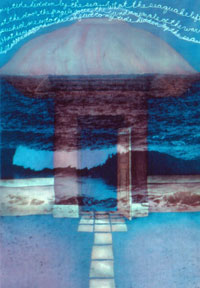 |
 |
 |
 |
 |
 |
 |
 |
 |
 |
 |
 |
 |

Review by Jorie Johnson “The
sea seeps in through the door, the door opened,
“[The artists] knew that there was a connectivity of thoughts coming from different places for each of them, but culminating in similar visual responses. Luanne is interested in the persistence and transience of things in the world. Ocean, stone, sky and earth become symbols for endurance and timelessness. Shadows, waves and poetic words become symbols for the ephemeral. By combining her interest with Betsy’s commitment to Buddhist concepts, they found an intriguing balance in collaborative work.” Although a rather new artistic relationship, one of merely eighteen months, this second and enhanced presentation of works shown in Japan by Benjamin and Rimel, took them much further on their collaborative journey. The twenty-eight joint and individual works presented were basically divided into three formats. Doorway size “soft scrolls” of layered images on silk, a fabric which offers a soft hazing like no other textile can, hung gently breathing on the walls, and these were set off by larger square hangings. The third form was of shikishi, which are cards (10 in. x 12 in.) used for Japanese painting and calligraphy (usually exhibited slipped into mounts on traditional vertical scrolls.) In the case of these shikishi works, images applied to silk fabric were subsequently adhered to the surface of the cards. Land, sky, waterscape, and shadow images were executed with acid and Procion dyes by hand application and brush work, dyes were also resisted by wax, soy, and dextrin, as well as clamps, gold powder stencil, photographic heat transfer, and ink jet print techniques were employed and manipulated for interesting effects. Crossing the threshold into modern expression where ancient Silk Road wax resist dyeing techniques are overlapping that of the technological advantages of the 21st century, many of the works presented examples of the capabilities of computer data gathering with jet ink print out on silk. Variations of text applications such as etched wax, silk screening, and hand-fashioned machine stitching techniques also appeared. In particular, it was the first time I had ever been introduced to the capability of etched wax work proving its application as an impressive form of intricate text execution. With borrowed text excerpts ranging from poems by the Chilean poet Pablo Neruda, Wu-Yu-hsiang (Essence of Tai Chi) and The Heart Sutra (Gate gate paragate parasmgate bodhi svaha), for example, there was much to contemplate as well as much to be absorbed from their offering and this was quite appropriate with the locale as Honen-in Temple is located along the famous strolling canal of Kyoto referred to as the Philosopher’s Path. “Door
to the Sea,” although originally painted by Benjamin while vacationing
on the coast of Bali, Indonesia, became transported and transformed into
the very recognizable main gate of Honen-in. One could get swept away
by wave, water, shadow and words while viewing the many works. Something
that the artist themselves experienced during the execution of the work
because they each had invited the other to join them on what turned out
to be a very intimate inner journey as well as physical trip to Japan
itself. Our modern convenient life styling, now decisively lacking in meditative depth and zones of tranquility, became even more evident the longer one spent on site. One Japanese visitor, aged 90 years, asked the artists if they didn’t think that most of the esoteric text and images floating around the venue weren’t miles over the heads of most of the visitors. But to the artists it was not a concern if one completely understood their intent but rather the wish for each visitor to make a connection or to take away a little something found that fit into their personal pocket. The opening party was attended by many of the Japanese artists who participated in the Massachusetts College of Art 2005 wax resist conference and exhibition, Rozome Masters of Japan, curated by Benjamin, as well as the foreign members of the tour group coordinated and led by Benjamin and running tandem to the show. The two artist’s first collaborative effort was presented during the 2005 Boston Wax Conference. Adding artistic vision to object, meaning and depth to image, adventure to friendship the works resulting in this second, traveling exhibition were thoughtful and calming and on view between April 22 through 27, 2006. This article first appeared in the Surface Design Journal, Winter 2007. Text copyrighted by Jorie Johnson and may not be used without permission from the author. |
